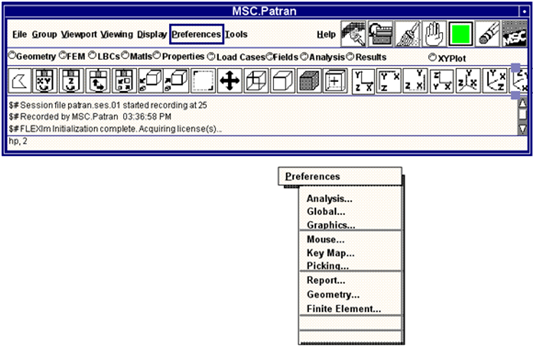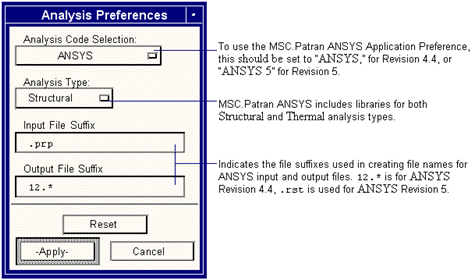


Supported Commands | ||||
! | DOMEGA | ITER | N | REAL |
ACEL | EC | KAN | NCNV | RMORE |
AFWRITE | ECDELE | KAY,1 | NEQIT | SAVE |
ALPHAD | EMORE | KAY,10 | NL | SFE |
ANTYPE | EN | KAY,2 | NLGEOM | SFEDELE |
AUTOTS | /EOF | KAY,3 | /NOPRINT | /SOLUTION |
/AUX1 | EP | KAY,4 | NROPT | SOLVE |
/BATCH | EPDELE | KAY,6 | NROTAT | SSTIF |
BCDCNV | ET | KAY,7 | NSUBST | /STITLE |
BETAD | EQSLV | KAY,8 | NT | /STRESS |
BF | /EXIT | KAY,9 | NTDELE | STRSET |
BFDELE | EXMOD | KBC | NUMEXP | T |
/BUCKLE | EXPASS | KEYOPT | OMEGA | TB |
BUCOPT | EXPSOL | KMPRPT | OUTPR | TBDATA |
CE | EXTMOD | KNROP | OUTRES | TBPT |
CERIG | F | KTEMP | PODISP | TBTEMP |
CESIZE | FDELE | LNSRCH | PONF | TDELE |
CNVR | FINISH | LOCAL | PORF | TIME |
CNVTOL | /GOPRINT | LUMPM | POSTR | /TITLE |
/COM | HARFRQ | LWRITE | PRDISP | TOFFST |
CONV | HF | M | PRED | TOTAL |
CP | HFDELE | MAT | /PREP7 | TREF |
CRPLIM | HFLOW | MODOPT | PRNF | TUNIF |
D | HREXP | MP | PRRF | |
DDELE | HROPT | MPDATA | PRSTR | |
DELTIM | HROUT | MPTEMP | PSTRES | |
DMPRAT | /INPUT,27 | MXPAND | R | |
Name | Description | Pages |
LINK1 | 2-Dimensional Spar | |
PLANE2 | 2-Dimensional 6-Node Triangular Solid | |
BEAM3 | 2-Dimensional Elastic Beam | |
BEAM4 | 3-Dimensional Elastic Beam | |
SOLID5 | Coupled Field Solid | |
LINK8 | 3-Dimensional Spar | |
LINK10* | Tension-only or Compression-only Spar | |
CONTAC12 | 2-Dimensional Preference | |
PLANE13 | 2-Dimensional Coupled Field Solid | |
COMBIN14 | Spring-Damper | |
PIPE16 | Elastic Straight Pipe | |
PIPE18 | Elastic Curved pipe or elbow | |
MASS21 | Generalized Mass | |
BEAM23 | 2-Dimensional Plastic Beam | |
SHELL28 | 4-Node Quadrilateral Shear⁄Twist Panel | |
LINK31 | Radiation Link | |
LINK32 | 2-Dimensional Heat Conduction Bar | |
LINK33 | 3-Dimensional Heat Conduction Bar | |
LINK34 | Convection Link | |
PLANE35 | 2-Dimensional 6-Node Triangular Thermal Solid | |
COMBIN40 | Combination | |
SHELL41* | Membrane Shell | |
PLANE42 | 2-Dimensional Isoparametric Solid | |
SHELL43 | Plastic Quadrilateral Shell | |
BEAM44 | 3-Dimensional Tapered Unsymmetrical Beam | |
SOLID45 | 3-Dimensional Isoparametric Solid | |
SOLID46 | 8-Node Layered Solid | |
SHELL51* | Axisymmetric Structural Shell | |
CONTAC52 | Three-Dimensional Point-Point Contact | |
BEAM54* | 2-Dimensional Tapered Unsymmetric Beam | |
PLANE55 | 2-Dimensional Isoparametric Thermal Solid | |
SHELL57 | Isoparametric Quadrilateral Thermal Shell | |
SHELL63 | Elastic Quadrilateral Shell | |
PLANE67 | Thermal -Electric 2D Solid | |
LINK68 | Thermal-Electric Line | |
SOLID69 | 3-Dimensional Thermal Electric Solid | |
SOLID70 | Isoparametric Thermal Solid | |
MASS71 | Lumped Thermal Mass with Variable Heat Generation | |
SOLID72* | 4-Node Tetrahedral Structural Solid with Rotations | |
SOLID73* | 3-Dimensional 8-Node Structural Solid with Rotations | |
PLANE77 | 2-Dimensional 8-Node Isoparametric Thermal Solid | |
PLANE82 | 2-Dimensional 8-Node Isoparametric Solid | |
SOLID87 | 10-Node Tetrahedral Thermal Solid | |
SOIID90 | 3-Dimensional 20-Node Isoparametric Thermal Solid | |
SHELL91 | 8-Node Layered Shell | |
SOLID92 | 3-Dimensional Tetrahedral Structural Solid | |
SHELL93 | 8-Node Isoparametric Shell | |
SOLID95 | 3-Dimensional three-dimensional Structural Solid | |
SOLID98 | Tetrahedral Coupled Field Solid | |
SHELL99 | 8-Node Layered Shell | |
Contac481 | 2D Point to Surface Contact | |
Contac49* | 3D Point to Surface Contact |